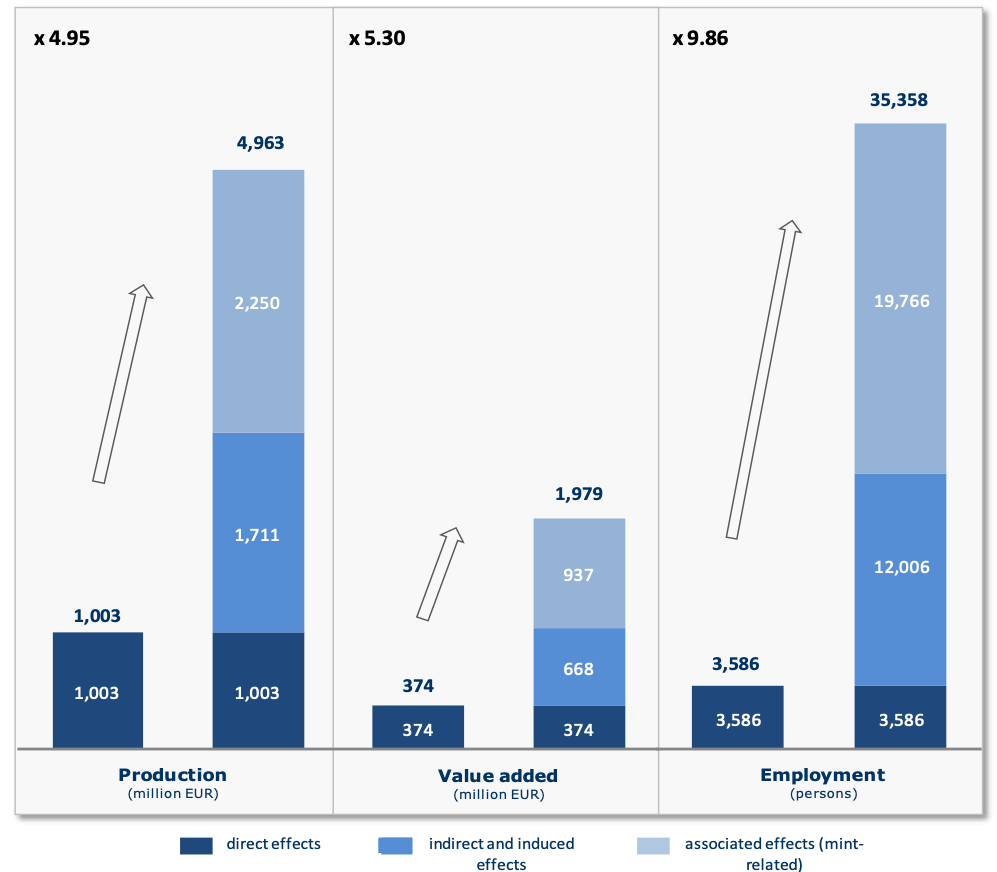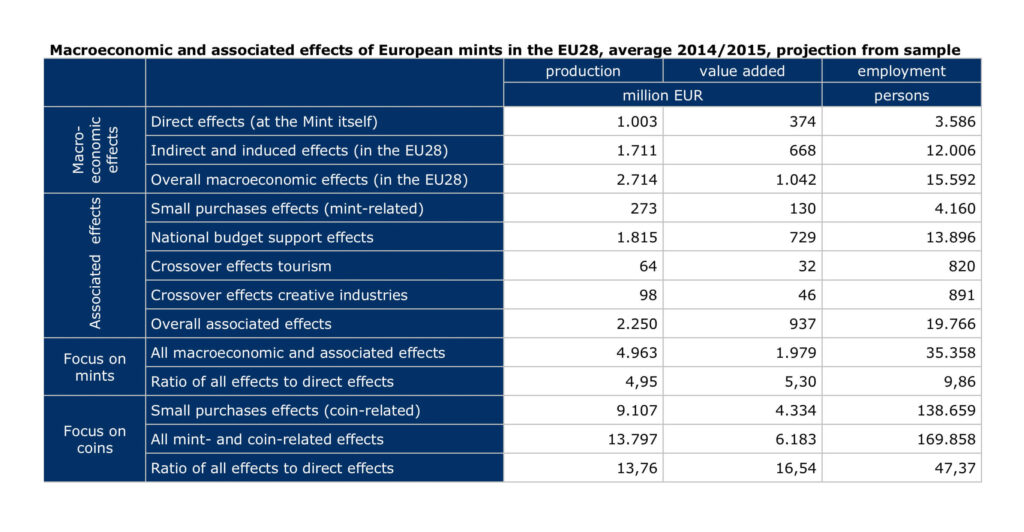
The Institute for Industrial Research [“Industriewissenschaftliches Institut”] in Vienna is presenting the first detailed study on the effects of coin minting on the economy and employment in the European Union. In short: The production of coins is worth it – for the countries and the people. When considering direct and indirect effects, the Mints are responsible for an aggregated production of EUR 13.797 billion. 169,900 people have jobs that are directly or indirectly linked to coin production.
The Scope of the Study
Every company has a larger impact than the numbers in its annual report show. Its existence is the basis for numerous other transactions, having a range of direct and indirect economic effects. For the first time, these effects have now been studied for the Mints of the European Union.

The following effects were taken into consideration:
- Direct effects: These include the production, the value added and the number of employees at mints.
- Indirect effects: Several suppliers and service providers depend on the production of coins, like for instance equipment manufacturers, raw material suppliers, logistics companies, etc. Their respective production, value added and number of employees are considered in this second dimension.
- Induced effects: Every person earning their salary directly or indirectly in connection with coin minting feeds it into the economy through their consumption. The third dimension considers the economic impact of that.

The study of these direct, indirect and induced effects is one of the basic tools in economics. Due to the specific nature of coins, their strategic importance and their role of directly providing cash to the public, a fourth financial dimension applies specifically to the coin business. The Institute for Industrial Research covers crossover, spillover and support effects in this fourth financial dimension:
- Small purchases effect: Many economic transactions hinge on the existence of coins, including small tips, machine purchases, donations etc.
- National budget financing effect: Since the production costs of coins are lower than their nominal value, every Mint creates added value which enters the national budget as seigniorage. The projects a state finances with the help of these funds in turn have further positive effects on the economy.
- Crossover and spillover effects in tourism: Every coin is a sort of miniature poster advertising a country, a region, an achievement in culture, sports or science, thus promoting tourism.
- Crossover and spillover effects in culture and creative industries: Coins possess a high recognition value and are therefore often taken up in cultural and creative processes.

The Results
Direct effects: The Mints in the European Union produce goods worth more than EUR 1 billion, with value added of EUR 374 million and 3,586 employees.
Indirect effects: The goods produced by the coin industry’s suppliers are worth EUR 7.711 billion, with value added of EUR 668 million and 12,006 employees.
Induced effects: The wages and profits generated in connection with coin minting and then re-fed into the cycle through consumption induce EUR 2.250 billion of production, with value added of EUR 937 million and 19,766 employees.
The overall value of the goods produced as a consequence of these three basic effects amounts to EUR 4.963 billion, with value added of EUR 1.979 billion. 35,358 employees earn their livelihood in connection with the production of coins.
Small purchases effects: The Institute for Industrial Research currently estimates the turnover depending on the existence of coins for the entire European Union at an average of 3% of a nation’s total turnover. In figures, that comes down to produced goods worth EUR 9.107 billion, with value added of EUR 4.334 billion and 138,659 employees.
However, the numbers vary significantly between the countries that were studied: Belgium came in at EUR 62.42 million, whereas Spain reached EUR 1.317 billion.
National budget financing effect: The contribution of the Mints to the national budgets generates EUR 1.815 billion of production, with value added of EUR 729 million and 13,896 employees.
Crossover and spillover effects in tourism and cultural industries: The effects considered generate EUR 162 million of production, with value added of EUR 78 million and 1,711 employees.
Thus, the associated effects add up to almost EUR 9 billion, with 134,499 people having a job thanks to these effects.
Overall the minting of coins generates almost EUR 14 billion of production and creates jobs for nearly 170,000 people.
The Data
For this study, the complete data of twelve Mints from eight European nations were analysed. The aggregated economic output of the included mints’ home countries covers approximately 63% of the entire EU economy.
The Institute for Industrial Research, Vienna
The Institute for Industrial Research is a non-profit association based in Vienna and has been doing research at the intersection of science and practice since 1986. Its special focus lies on studies of industrial networks, so-called cluster analyses.
This study was led by FH-Hon.-Prof. DDr. Herwig Schneider, the Institute’s director.



